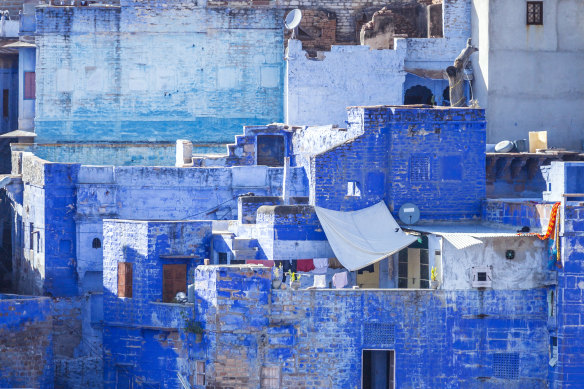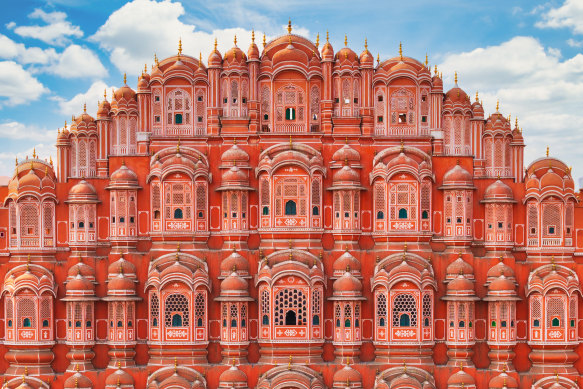The secret spots to visit in India’s famous ‘pink’ and ‘blue’ cities
I’m lost. I’ve wandered into a part of Jodhpur just below the city’s hilltop fort, and now I’m drifting through a tangled maze of narrow corridors winding between houses joined wall-to-wall, all painted blue to echo the cloudless sky above this Indian desert city. For the second time I’m passing the same tiny square where a man is pressing laundry using a heavy iron filled with hot coals. He nods in the direction of a downward alleyway, I follow and in five minutes I’m back on the city’s chaotic ground floor.
Subtitled “India’s Blue City” for this dense, cubist quarter where the city’s high-caste Brahmins have painted their houses with indigo wash since time immemorial, Jodhpur is the seat of the Rathore royal family and one of India’s most likeable and manageable cities. Dominating the city from its flat-topped hill, Mehrangarh Fort is among the most impressive in India, its ochre walls radiating military might and majesty. Contrasting with the cliff-like exterior, the interior is a jewel box, a succession of palaces overlooking cloistered courtyards from where the women of the former harem observed the world from behind honeycombed windows.

Jodhpur or “India’s Blue City” where the city’s high-caste Brahmins have painted their houses with indigo wash .Credit: Getty Images/iStockphoto
Mehrangarh is one of the few forts in Rajasthan still in the hands of the ancestral royal family, and it shows. While most of these palace fortresses have been stripped by bureaucrats and politicians, here the royal suites are still furnished in opulent style, as if their owners just stepped out to inspect the household cavalry. Today, centuries after it ceased to have any military function, Mehrangarh’s fairytale architecture and walled gardens have become the venue for a lively festival calendar, hosting such events as Jodhpur RIFF, the Rajasthan International Folk Festival and the Sacred Spirit Festival.
Below the fort the old city is a sprawl of bazaars, cafes, boutiques, fabric shops and tailors who will whip you up a pair of the baggy riding trousers that take their name from the city. Jodhpur is famous for its sweets and on the main street leading to Clock Tower Bazaar, Janta Sweet Home is packed with oozing baklavas, walnut pastries, halwas and laddus, made from cardamom, cashews, lemon juice and sugar, moulded into a ball and encased in rose petals. Under the arched gateway of the Clock Tower, the Mishrilal lassi shop is a city institution. Brave the crowd inside, plonk yourself down and without a word, a glass of the legendary lassi will appear before you, cream on top.
Another source of fame is its antique shops. If you’re in the market for a marble jaali screen, a chest decorated in the florid Rajasthani style or a studded door, the antique shops of Jodhpur are the place. Another must for shoppers, the Jain fabric emporium is known to all the city’s guides, where the eponymous Mr Jain will unfurl pashminas, carpets, rugs, throws and scarves that will have you gasping, at miraculous prices too. You will not leave empty-handed.
While Jodhpur has its fair share of palace hotels, RAAS Jodhpur is a luxury hotel with a cool, contemporary aesthetic. Set behind studded gates close to the main bazaar, the architecture blends the flowery extravagance of the former family haveli with a modernist wing behind slit jaali screens. The effect verges on minimalism but inside each room is a miracle of crisp comfort while the Mediterranean-inspired menu at the rooftop Darikhana Restaurant plucks the taste buds like a sitar. A romantic alternative, The Rohet House is a gorgeous boutique hotel tucked away in a quiet corner of the city where the eight spacious suites are hand-painted with peacocks and palm trees.
North-east of Jodhpur, Jaipur is the state capital of Rajasthan, known to all as “India’s Pink City”. Early in the 18th century, on level ground at the foot of the Aravalli Hills, Maharaja Jai Singh II laid out a grid of streets wide enough for parades of elephants six abreast, giving the city a spacious heart that still defines its character. More than a century later, in honour of a visit by the Prince of Wales, Maharaja Ram Singh II decreed that the whole city be painted pink, and both the colour and the pink city tag stuck.

Hawa Mahal, “Palace of the Winds”, in Jaipur.Credit: Getty Images
Jaipur is a bustling, energetic city but despite the crowds the verandas that line the boulevards within the old city make this a user-friendly experience for taking in the sari merchants, tailors, wedding bangle makers, sweet sellers and samosa makers who ply their trade from open-fronted shops. At its heart the wonderful City Palace is crammed with weaponry, miniature paintings and elaborate costumes dating from the glory days of the Rajputs who ruled the state. One of the façades of the palace is the Hawa Mahal, “Palace of the Winds”, its intricate latticework a gift to the city’s postcard sellers and travellers in search of the perfect Instagram backdrop.
Located a few kilometres from the city, Amber Fort is one of the staples of the Indian experience, a mighty and imposing palace-stronghold set high on a ridge and casting its reflection across the lake at its feet. Opposite the main gate of the fort, the jeep road takes you down a winding path past the wonderful Shri Jagat Shiromani ji Temple, the Panna Meena ka Kund stepwell and finally to the Anokhi Museum of Hand Printing. Wood-block printing is a Rajasthani specialty and the museum is a treasure house of fabrics printed in this age-old technique. If you’re inspired to buy, Brigitte Singh is a textile designer and one of the leading exponents of wood-block printing with an atelier that produces a sumptuous range of soft furnishings close to the fort in the village of Amer.
Jaipur is one of the centres of India’s jewellery trade, and nowhere else does bling quite like India. Gem Palace is the oldest and most revered of the city’s jewellery emporia, while M. I. Road is home to several iconic jewellers including Birdhichand Ghanshyamdas, a favourite for brides looking to add some sparkle to their wedding day. For something very special, Sunita Shekhawat has an amazing ‘Bougainvillea’ collection that uses a French technique to create a translucent surface on enamelled jewellery.
Jaipur has made a fetish of its palace hotels, and Samode Haveli, former in-town residence of the Samode royal family, bears witness to the luxury and leisure that was once the divine right of the rulers of princely India. Scalloped arches frame palmy courtyards, the salons feel like an Indian Palace of Versailles and there’s a purpose-built ramp if you arrive by elephant. Each of the 39 rooms is different, each another chapter from the rich life and times of the House of Samode. Antique furnishings, tiled floors, Oriental carpets, inlaid chests and hand-painted murals are standard, while bathrooms show all the benefits of modern plumbing. If it’s kite-flying season, head for the rooftop bar toward sunset and watch the duelling kites dance against the darkening sky.
A less sumptuous option, 47 Jobner Bagh is a delight, a small, friendly, family-run hotel that describes its style as “uncomplicated luxury”, popular with foreign buyers who come to Jaipur to stock their boutiques. As one of them told me, for jewellery, textiles, bangles, rugs, homewares and stationery, for cottons, silks and pashminas, bedroom to catwalk, there’s nowhere like Jaipur, “and the colours are just sensational.”
Get the best of Sunday Life magazine delivered to your inbox every Sunday morning. Sign up here for our free newsletter.